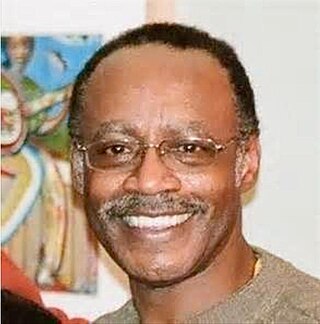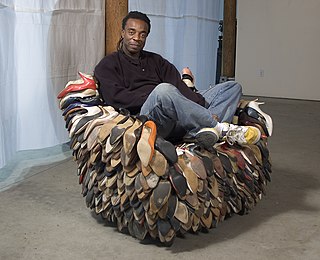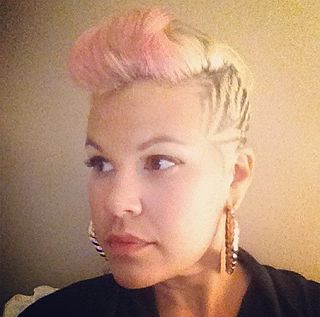Willie Little (born December 25, 1961) is a conceptual, multimedia, installation artist and storyteller, whose work is strongly influenced by traditions of rural North Carolina. [1]
Willie Little (born December 25, 1961) is a conceptual, multimedia, installation artist and storyteller, whose work is strongly influenced by traditions of rural North Carolina. [1]
Little was born and grew up on a tobacco farm in Pactolus Township, North Carolina. He carried vibrant childhood memories of life around his parents' grocery store into his artwork. He graduated from University of North Carolina at Chapel Hill with a degree in Communications. [2] Little then lived in Charlotte, N.C., for 18 years. After a 2002 residency at the Headlands Center for the Arts in California, he moved to the San Francisco area where he still lives. [3]
After college, Little received a series of three grants that allowed him to create a nearly life-size multimedia installation in 1995 that depicts the store and bar titled Juke Joint. Little recreated bar patrons using mannequins sculpted over with paper, clay, peat moss and acrylic paint. He also developed an accompanying audio narrative that was played on a jukebox in the exhibit based on recollected banter from the cast of characters who patronized the bar and music from the late '60s . [4] "I witnessed dancing and romancing to the soulful sounds of Clarence Carter, Wilson Pickett and Aretha Franklin--pickled eggs and pickled pig's feet, along with a quick 50 cent shot of gin in a Dixie paper cup," Little said. [5] Juke Joint also traveled to other cities including to the African-American Museum in Dallas. [4] Samella S. Lewis in her book African American Art and Artists wrote, "Juke Joint is a portal through time to a vanished way of life." [4] Establishments like Little's family grocery were a common feature in communities in the South. His parents' store closed in 1980. [6] A smaller version of Juke Joint first opened in 1994 at the Afro-American Cultural Center in Charlotte, N.C. Little then incorporated the original installation and took it to a larger scale. [7]
In 2003, the Juke Joint exhibit was on display at the Smithsonian Institution Arts and Industries Building in Washington, D.C. and is part of the Smithsonian's permanent collection. [8] At the installation's opening Washington Post Art Critic Paul Richard comment that all the authentic details and design rendered the installation lyrical. "'Juke Joint' is like three-dimensional blues, but a grateful blues." [6]
Little's work is often driven by political and social commentary. During a printmaking residency at Caversham Press in Kwa Zulu Natal, South Africa in 2000, Little created a series he called "Baggage," reflecting what he described in an interview as America's baggage: self-righteousness and use of the Bible to justify bigotry. [9] Race and a black-and-white divide are central to some of his works. In 2008, he created an exhibit and show titled In Mixed Company at the Levine Museum of the New South in Charlotte, N.C. [3] [10] The installation is a small room filled with artifacts and memorabilia from white and black worlds with a wall of stinging nettles separating them. Little carefully selected each of the hundreds of eclectic objects he used for its symbolism. In Mixed Company includes an old tin of Premium Crackers, emphasizing the word Crackers, a derogatory term for rural white people; a gilded gold leaf box lined with confederate 20 dollar bills; and carved African walking sticks. [10] Little as the storyteller was part of the show, engaging museum patrons with stories from his childhood, including a tale told by an elderly African American neighbor about "the curse" of nappy hair. [10]
[11] In 2010 with a grant from the prestigious Pollock-Krasner Foundation, Little began to create artistic commentary on racism in the Tea Party movement. In the variety of medium in which he works, sculpting, painting, and multimedia creations, he linked the new Tea Party to what he believes is a modern Ku Klux Klan. [12] For a 2014 exhibit In the Hood at the New Gallery of Modern Art in Charlotte, N.C., he created a 20-foot-tall, walk-in Ku Klux Klan hood. [1] Inside the giant hood was a life-size sculpture of an enslaved South African woman, Sarah Baartman, who'd been forced to appear in London freak shows to display her exceptionally large buttocks. Little made her skirt from 1,000 hand-dipped black teabags. In the Hood also features artifacts of racism surrounded by symbols of hip-hop music, which Little said is a way of linking and antagonizing the KKK with the culture it hates. [1]
Little works in many media, including abstract rust painting, also called oxidation painting, where mediums such as acid and water are applied to a base of such as metal, paper or fabric. [13] Among his rust paintings is a series titled Blue Moon. In a magazine interview, Little said the red rust is reminiscent of North Carolina's red clay soil and rusty tin roofs, and the cerulean blue that appears among abstract forms, its sky. [3] A life-threatening illness in 2013, propelled Little's work in oxidation painting. "During my recovery, these multimedia paintings — beginning with Blood Orange — metaphorically reflected my intense anger, rage, passion and desire to dig myself out from near death with a resilience and determination to gouge and scrape away from the surface — the dark disparity — into the light of life, survival to thrive, give thanks and have gratitude to be alive." [11]
Little's work is included in the prestigious John and Vivian Hewitt Collection of African-American Art. [14] Charlotte's public radio station WFAE mentioned him in an article about artist Heather Hart's project to include more African American artists in Wikipedia. [15]
In June 2016, Little returned to the McColl Center for Art + Innovation in Charlotte, N.C., for an exhibit titled "prompt" created by three alumni artists-in-residence. Little was a resident artist at McColl in 1999. The alumni were given four weeks to create individual installations based on three prompts: the words "divisions and differences" must be a catalyst, the artists must use a material, process or approach new to him or her, and it must have an interactive element with viewers. [16] Little's mixed media installation "American Obsession" (shown in this wiki page profile in the upper right corner) examines gun violence, race, and standards of beauty, according to a statement by the artist which accompanied the work. "Lips and backsides, dating back to the Hottentot Venus in the 1800s, once ridiculed and mocked, are now a premium to achieve, speaking to the influence of Black Culture on the world," Little wrote. "Chains, like the one attached to the figure you see here, symbolize enslavement and restriction. Sometimes being constricted can force creative resilience." Gallery guests were invited to engage with the installation by repositioning a toy AK-47 to suggest whether the beautiful woman in the painting is a victim, victor or neither. He tapped into an American obsession with selfies by encouraging viewers to take selfies with the installation and post them at #AmericanObsession.
Little's work has been shown in many group and solo exhibitions. [4]

Juke joint is the vernacular term for an informal establishment featuring music, dancing, gambling, and drinking, primarily operated by African Americans in the southeastern United States. A juke joint may also be called a "barrelhouse". The Jook was the first secular cultural arena to emerge among African American Freedmen.

Samella Sanders Lewis was an American visual artist and art historian. She worked primarily as a printmaker and painter. She has been called the "Godmother of African American Art". She received Distinguished Artist Award for Lifetime Achievement from the College Art Association (CAA) in 2021.
“Art is not a luxury as many people think – it is a necessity. It documents history – it helps educate people and stores knowledge for generations to come.” – Dr. Samella Lewis
Alison Saar is a Los Angeles, California based sculptor, mixed-media, and installation artist. Her artwork focuses on the African diaspora and black female identity and is influenced by African, Caribbean, and Latin American folk art and spirituality. Saar is well known for "transforming found objects to reflect themes of cultural and social identity, history, and religion."
The Highwaymen, also referred to as the Florida Highwaymen, are a group of 26 African American landscape artists in Florida. Two of the original artists, Harold Newton, and Alfred Hair, received training from Alfred “Beanie” Backus. It is believed they may have created a body of work of over 200,000 paintings. They challenged many racial and cultural barriers. Mostly from the Fort Pierce area, they painted landscapes and made a living selling them door-to-door to businesses and individuals throughout Florida from the mid-1950s through the 1980s. They also sold their work from the trunks of their cars along the eastern coastal roads.
Renee Stout is an American sculptor and contemporary artist known for assemblage artworks dealing with her personal history and African-American heritage. Born in Kansas, raised in Pittsburgh, living in Washington, D.C., and connected through her art to New Orleans, her art reflects this interest in African diasporic culture throughout the United States. Stout was the first American artist to exhibit in the Smithsonian's National Museum of African Art.

Pheoris West was an African-American artist. He was an Associate Professor Emeritus Ohio State University College of the Arts, where he joined the faculty in 1976.
Louis Jessup Delsarte III was an African-American artist known for what has sometimes been called his "illusionistic" style. He was a painter, muralist, printmaker, and illustrator.

Willie Cole is a contemporary American sculptor, printer, and conceptual and visual artist. His work uses contexts of postmodern eclecticism, and combines references and appropriation from African and African-American imagery. He also has used Dada’s readymades and Surrealism’s transformed objects, as well as icons of American pop culture or African and Asian masks.

Heather T. Hart is an American visual artist who works in a variety of media including interactive and participatory Installation art, drawing, collage, and painting. She is a co-founder of the Black Lunch Table Project, which includes a Wikipedia initiative focused on addressing diversity representation in the arts on Wikipedia.
Joyce J. Scott is an African-American artist, sculptor, quilter, performance artist, installation artist, print-maker, lecturer and educator. Named a MacArthur Fellow in 2016, and a Smithsonian Visionary Artist in 2019, Scott is best known for her figurative sculptures and jewelry using free form, off-loom beadweaving techniques, similar to a peyote stitch. Each piece is often constructed using thousands of glass seed beads or pony beads, and sometimes other found objects or materials such as glass, quilting and leather. In 2018, she was hailed for working in new medium — a mixture of soil, clay, straw, and cement — for a sculpture meant to disintegrate and return to the earth. Scott is influenced by a variety of diverse cultures, including Native American and African traditions, Mexican, Czech, and Russian beadwork, illustration and comic books, and pop culture.

Jennie C. Jones is an African-American artist living and working in Brooklyn, New York. Her work has been described, by Ken Johnson, as evoking minimalism, and paying tribute to the cross-pollination of different genres of music, especially jazz. As an artist, she connects most of her work between art and sound. Such connections are made with multiple mediums, from paintings to sculptures and paper to audio collages. In 2012, Jones was the recipient of the Joyce Alexander Wien Prize, one of the biggest awards given to an individual artist in the United States. The prize honors one African-American artist who has proven their commitment to innovation and creativity, with an award of 50,000 dollars. In December 2015 a 10-year survey of Jones's work, titled Compilation, opened at the Contemporary Arts Museum in Houston, Texas.

Juan Logan is an American artist from Nashville, Tennessee. His paintings, sculptures, and installations are reflective of his experiences of racial and institutional power structures in the South and prompt viewers to consider social responsibility.

Thomas James "T. J." Reddy was an American artist, poet, activist, and musician.
Carita Letitia Huckaby is an American photographer who creates multimedia artwork combining photography and textiles to depict both family narratives and African American history.
Nellie Ashford is a self-taught folk artist from Mecklenburg County, North Carolina. Her mixed-media folk art depicts the experiences of Charlotte’s African-American community during the era of Jim Crow in the U.S. South.

Suzanne Jackson is an American visual artist, gallery owner, poet, dancer, educator, and set designer; with a career spanning five decades. Her work has been exhibited in museums and galleries around the world. Since the late 1960s, Jackson has dedicated her life to studio art with additional participation in theatre, teaching, arts administration, community life, and social activism. Jackson's oeuvre includes poetry, dance, theater, costume design, paintings, prints, and drawings.
Kevin Blythe Sampson is an American artist and retired police officer living in Newark, New Jersey. He makes sculptures from discarded found objects that act as memorials for various people who have died. He has a studio based out of Newark.
Endia Beal is an African-American visual artist, curator, and educator. She is known for her work in creating visual narratives through photography and video testimonies focused on women of color working in corporate environments.
John Edmonds is an artist working in photography who lives and works in Brooklyn, New York.
Adolphus Ealey (1941–1992) was an American artist, curator, educator, writer, and entrepreneur. He was African-American noted Black art authority, and he was the longtime curator of the Barnett–Aden Collection of Black art.